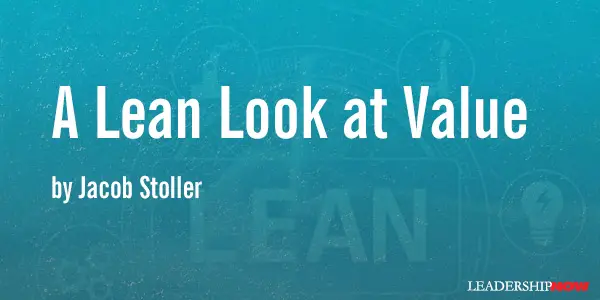 |
 |
05.18.15

A Lean Look at Value
“Price is what you pay. Value is what you get,” said Warren Buffett, adeptly observing that value is more than just a notion of what something is worth. Customer value that is based on substance, as opposed to perceptions, is widely pursued by organizations that aspire to greatness and is also a fundamental building block of the Lean management system. One of Lean’s great triumphs is that it breaks value down into a set of metrics that can be actively pursued. Leaders who aspire to excellence can gain much from studying this approach. Separating value from waste Toyota, who pioneered Lean methods in the wake of World War II, learned how to maximize value under dire circumstances. Desperate to make the most of scarce resources, they began a relentless campaign to eradicate any expenses or activities that didn’t contribute directly to the value that customers would willingly pay for. In other words, maximizing value – Buffett’s proverbial “what you get” - was a process of elimination. For example, an assembler installing a mirror on a vehicle was at that moment adding value. Walking across the plant to retrieve a screwdriver while the vehicle sat idle, however, was considered non-value or waste. If there were more workers than necessary assembling the car, or more parts than needed in inventory, these were considered wastes that added unnecessary cost to the vehicle. The key here is that the workpiece is treated as a proxy for the customer. It’s almost as if extra walking was keeping the customer waiting, or extraneous activity was wasting the customer’s money. This applies in any industry, whether the workpiece is a manufactured product, a meal in preparation, or an insurance claim under review. In healthcare, the workpiece and the customer are the same, making non-value activity waiting particularly visible and objectionable. Where’s the customer? In Lean organizations, all efforts are focused on the customer experience. To support this, Lean organizations drive improvement using metrics that pertain directly to customer value, such as defect rates, on-time delivery, lead times, and cost indicators such as inventory turns. It also prioritizes roles according to customer value – the closer you are to the customer, the more important the work is. In a factory, the shop floor workers who produce the goods are the most important. In a hospital, it’s the hands-on care workers. In an insurance company, it’s the representatives that are on the phone handling customer claims. This approach has profound implications for employees who don’t make products or interact with customers. By the Lean definition, non-production activity, including IT, engineering, HR, accounting, and yes, senior management, can only provide value indirectly through their support of production. This calls for some major role shifts. HR, instead of sponsoring leadership courses, might spend more time in the workplace helping employees develop problem-solving skills. Accounting, instead of trying to explain variances for the past quarter, might spend their time developing real-time reports to help production supervisors make better buying decisions. And senior managers might step out of the executive suite and find out what more they can do to support their value-creating workers. When assessing whether an activity has value, everything stems from one question: “Why would our customers pay for this?” If the answer is “I don’t know,” maybe it’s time to eliminate it.  
Posted by Michael McKinney at 12:11 PM
|
BUILD YOUR KNOWLEDGE
 

How to Do Your Start-Up Right STRAIGHT TALK FOR START-UPS 
Grow Your Leadership Skills NEW AND UPCOMING LEADERSHIP BOOKS 
Leadership Minute BITE-SIZE CONCEPTS YOU CAN CHEW ON 
Classic Leadership Books BOOKS TO READ BEFORE YOU LEAD |